belt CHRYSLER CROSSFIRE 2007 1.G Owners Manual
[x] Cancel search | Manufacturer: CHRYSLER, Model Year: 2007, Model line: CROSSFIRE, Model: CHRYSLER CROSSFIRE 2007 1.GPages: 299, PDF Size: 8.26 MB
Page 8 of 299

mPower Windows........................21
NPower Window Operation With The
Convertible Top Switch (Roadster Only)......22
mRear Liftgate/Decklid Release..............23
mOccupant Restraints.....................23
NLap/Shoulder Belts.....................24
NSeat Belts And Pregnant Women............29
NSeat Belt Extender......................29
NSupplemental Restraint System
(SRS) - Airbag.........................30NChild Restraint........................47
mEngine Break-In Recommendations..........55
mSafety Tips............................55
NExhaust Gas..........................55
NSafety Checks You Should Make Inside
The Vehicle..........................56
NPeriodic Safety Checks You Should Make
Outside The Vehicle....................56
8 THINGS TO KNOW BEFORE STARTING YOUR VEHICLE
Page 23 of 299

REAR LIFTGATE/DECKLID RELEASE
You can open the rear liftgate/decklid by using the
handle located on the liftgate/decklid just above the rear
license plate pocket.
WARNING!
Do not allow children to have access to the rear cargo
area by climbing into the rear cargo area from out-
side. Always close the liftgate/decklid when your
vehicle is unattended. Once in the cargo area, young
children may have difficulty leaving the vehicle. If
trapped in the cargo area, children can die from
suffocation or heat stroke.
OCCUPANT RESTRAINTS
Some of the most important safety features in your
vehicle are the restraint systems. These include the lap/
shoulder seat belts for the driver and passenger, emer-
gency tensioning retractors for the seat belts, and front
and side airbags for the driver and passenger. If you will
be carrying children too small for adult-size belts, the
passenger side seat belt also can be used to hold infant
and child restraint systems.
Please pay close attention to the information in this
section. It tells you how to use your restraint system
properly to keep you and your passengers as safe as
possible.
WARNING!
In a collision, you and your passengers can suffer
much greater injuries if you are not properly buckled
up. You can strike the interior of your vehicle or other
occupants, or you can be thrown out of the vehicle.
Always be sure you and others in your vehicle are
buckled up properly.
THINGS TO KNOW BEFORE STARTING YOUR VEHICLE 23
2
Page 24 of 299

Buckle up even though you are an excellent driver, even
on short trips. Someone on the road may be a poor driver
and cause a collision that includes you. This can happen
far away from home or on your street.
Research has shown that seat belts save lives. They also
can reduce the seriousness of injuries in a collision. Some
of the worst injuries happen when people are thrown
from the vehicle. Seat belts provide protection from that,
and they reduce the risk of injury caused by striking the
inside of the vehicle.Everyonein a motor vehicle needs
to be buckled up all the time.
Lap/Shoulder Belts
Each seating position is equipped with a combined
lap/shoulder belt system.
The belt webbing retractor will lock only during very
sudden stops or impacts. This feature allows the shoulder
part of the belt to move freely with you under normalconditions. In a collision, the belt locks and reduces the
risk of your striking the inside of the vehicle or being
thrown out. The seat belts are also equipped with emer-
gency tensioning retractors. These tensioning retractors
are located in each belt's inertia reel and become opera-
tionally ready with the key in the ignition switch turned
to the ACC or ON/RUN positions. The emergency
tensioning retractors are designed to activate during
frontal and rear impacts. They remove slack from the
belts in such a way that the seat belts fit more snugly
against the body, restricting its forward movement as
much as possible.
In cases of other frontal impacts, roll overs, certain side
impacts, rear collisions or other accidents without suffi-
cient frontal or rear impact forces, the emergency tension-
ing retractors will not be activated. The driver and
passenger will then be protected by the fastened seat
belts and inertia reel in the usual manner.
24 THINGS TO KNOW BEFORE STARTING YOUR VEHICLE
Page 25 of 299
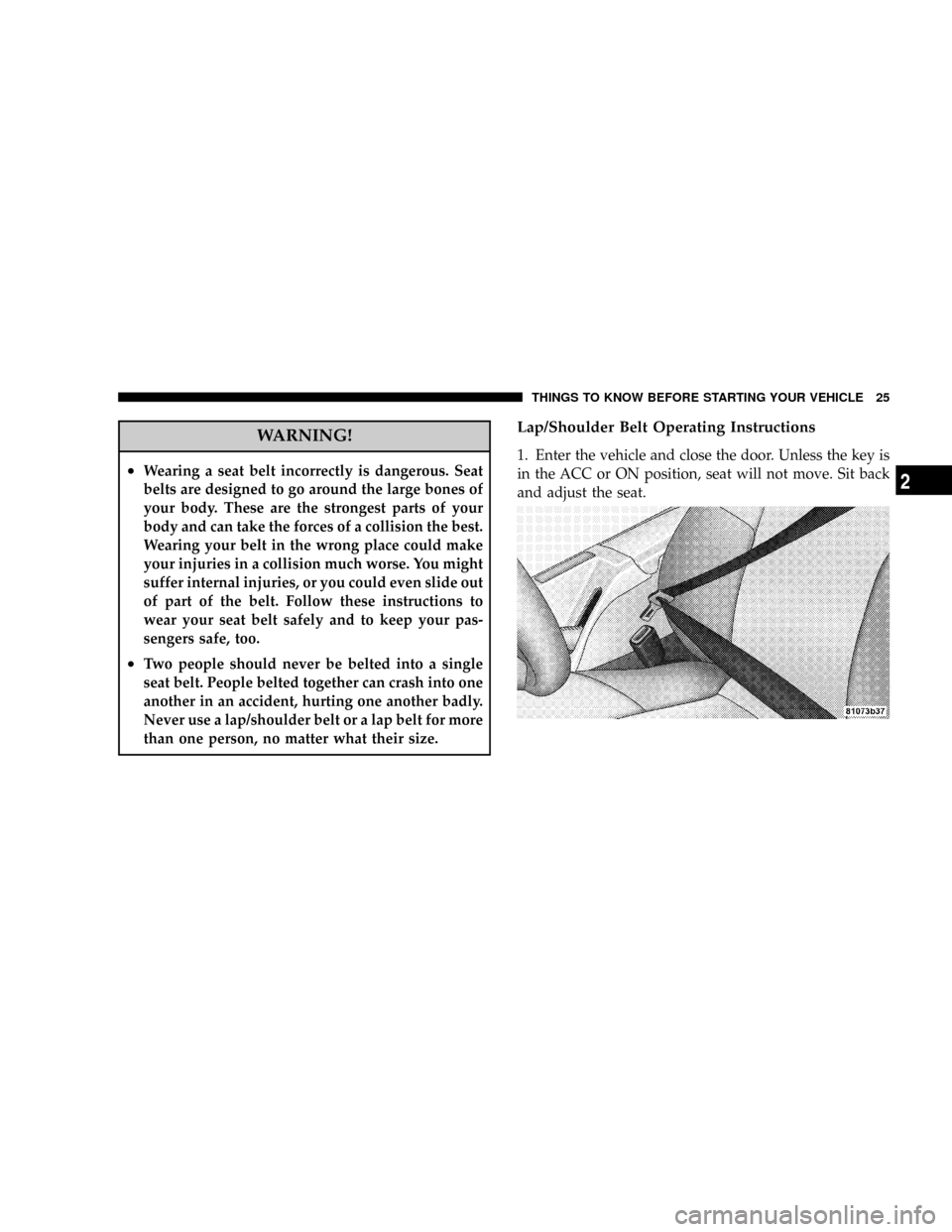
WARNING!
²Wearing a seat belt incorrectly is dangerous. Seat
belts are designed to go around the large bones of
your body. These are the strongest parts of your
body and can take the forces of a collision the best.
Wearing your belt in the wrong place could make
your injuries in a collision much worse. You might
suffer internal injuries, or you could even slide out
of part of the belt. Follow these instructions to
wear your seat belt safely and to keep your pas-
sengers safe, too.
²Two people should never be belted into a single
seat belt. People belted together can crash into one
another in an accident, hurting one another badly.
Never use a lap/shoulder belt or a lap belt for more
than one person, no matter what their size.
Lap/Shoulder Belt Operating Instructions
1. Enter the vehicle and close the door. Unless the key is
in the ACC or ON position, seat will not move. Sit back
and adjust the seat.
THINGS TO KNOW BEFORE STARTING YOUR VEHICLE 25
2
Page 26 of 299

2. The seat belt latch plate is above the back of your seat.
Grasp the latch plate and pull out the belt. Slide the latch
plate up the webbing as far as necessary to make the belt
go around your lap.3. When the belt is long enough to fit, insert the latch
plate into the buckle until you hear a ªclick.º
4. Position the lap belt across your thighs, below your
abdomen. To remove slack in the lap belt portion, pull up
a little on the shoulder belt, as shown.
26 THINGS TO KNOW BEFORE STARTING YOUR VEHICLE
Page 27 of 299
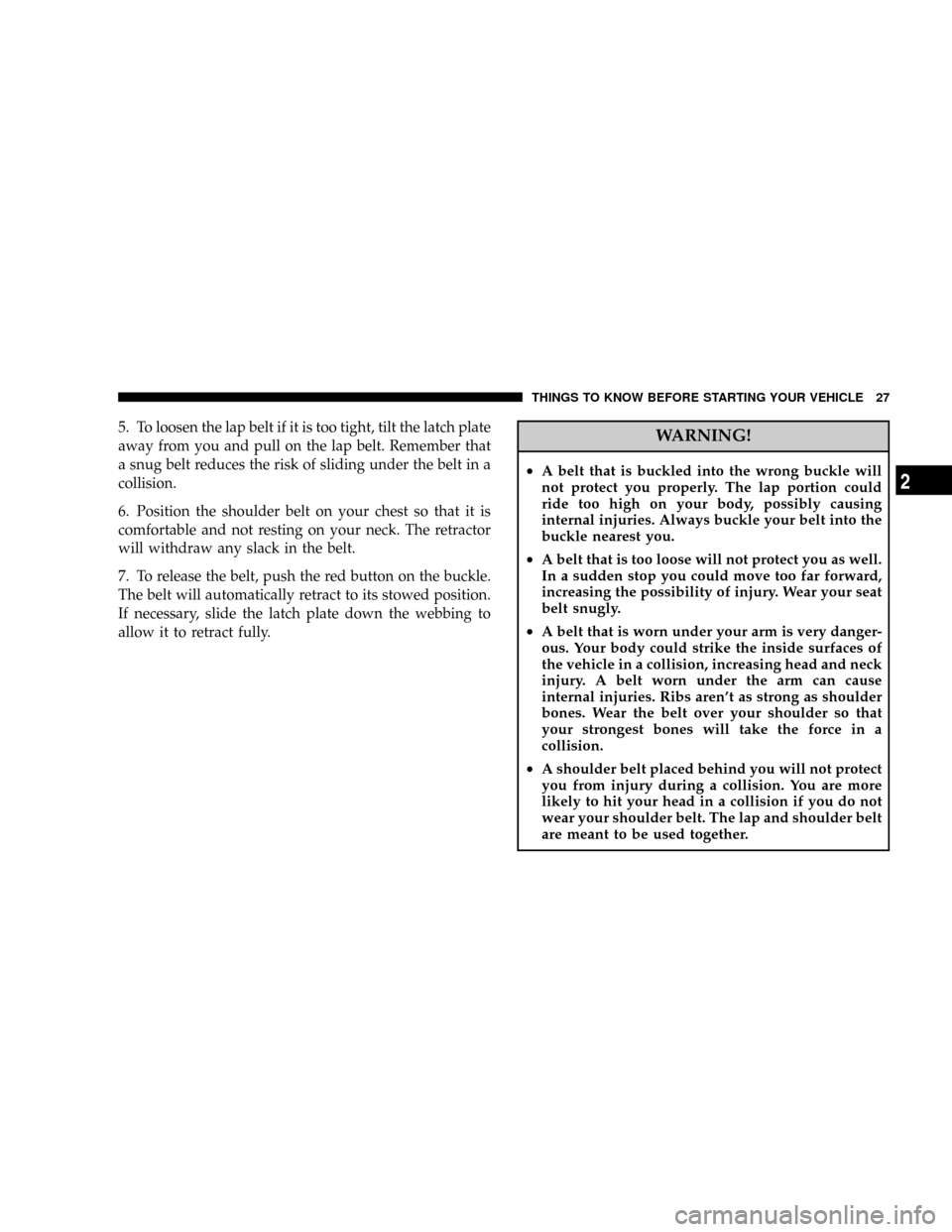
5. To loosen the lap belt if it is too tight, tilt the latch plate
away from you and pull on the lap belt. Remember that
a snug belt reduces the risk of sliding under the belt in a
collision.
6. Position the shoulder belt on your chest so that it is
comfortable and not resting on your neck. The retractor
will withdraw any slack in the belt.
7. To release the belt, push the red button on the buckle.
The belt will automatically retract to its stowed position.
If necessary, slide the latch plate down the webbing to
allow it to retract fully.WARNING!
²A belt that is buckled into the wrong buckle will
not protect you properly. The lap portion could
ride too high on your body, possibly causing
internal injuries. Always buckle your belt into the
buckle nearest you.
²A belt that is too loose will not protect you as well.
In a sudden stop you could move too far forward,
increasing the possibility of injury. Wear your seat
belt snugly.
²A belt that is worn under your arm is very danger-
ous. Your body could strike the inside surfaces of
the vehicle in a collision, increasing head and neck
injury. A belt worn under the arm can cause
internal injuries. Ribs aren't as strong as shoulder
bones. Wear the belt over your shoulder so that
your strongest bones will take the force in a
collision.
²A shoulder belt placed behind you will not protect
you from injury during a collision. You are more
likely to hit your head in a collision if you do not
wear your shoulder belt. The lap and shoulder belt
are meant to be used together.
THINGS TO KNOW BEFORE STARTING YOUR VEHICLE 27
2
Page 28 of 299
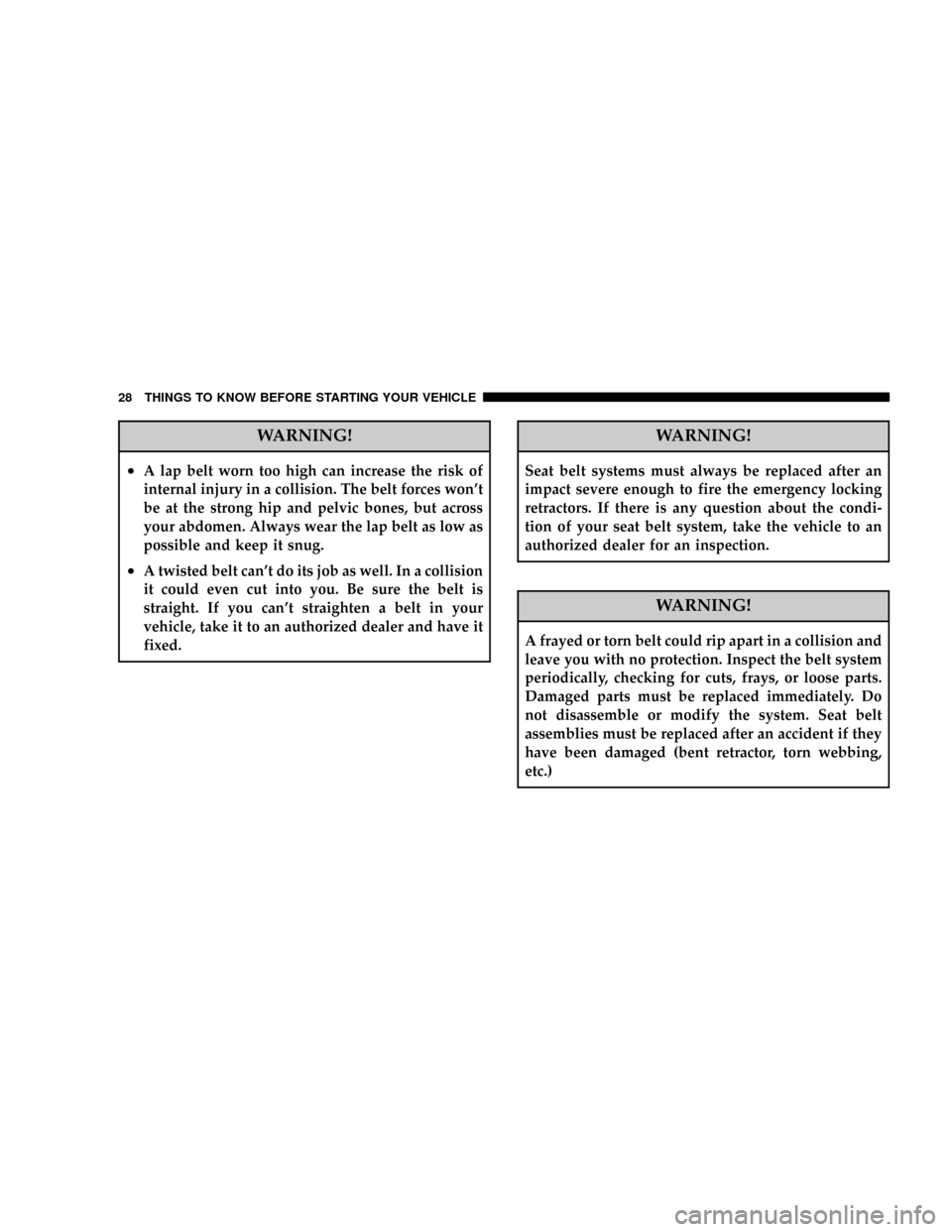
WARNING!
²A lap belt worn too high can increase the risk of
internal injury in a collision. The belt forces won't
be at the strong hip and pelvic bones, but across
your abdomen. Always wear the lap belt as low as
possible and keep it snug.
²A twisted belt can't do its job as well. In a collision
it could even cut into you. Be sure the belt is
straight. If you can't straighten a belt in your
vehicle, take it to an authorized dealer and have it
fixed.
WARNING!
Seat belt systems must always be replaced after an
impact severe enough to fire the emergency locking
retractors. If there is any question about the condi-
tion of your seat belt system, take the vehicle to an
authorized dealer for an inspection.
WARNING!
A frayed or torn belt could rip apart in a collision and
leave you with no protection. Inspect the belt system
periodically, checking for cuts, frays, or loose parts.
Damaged parts must be replaced immediately. Do
not disassemble or modify the system. Seat belt
assemblies must be replaced after an accident if they
have been damaged (bent retractor, torn webbing,
etc.)
28 THINGS TO KNOW BEFORE STARTING YOUR VEHICLE
Page 29 of 299
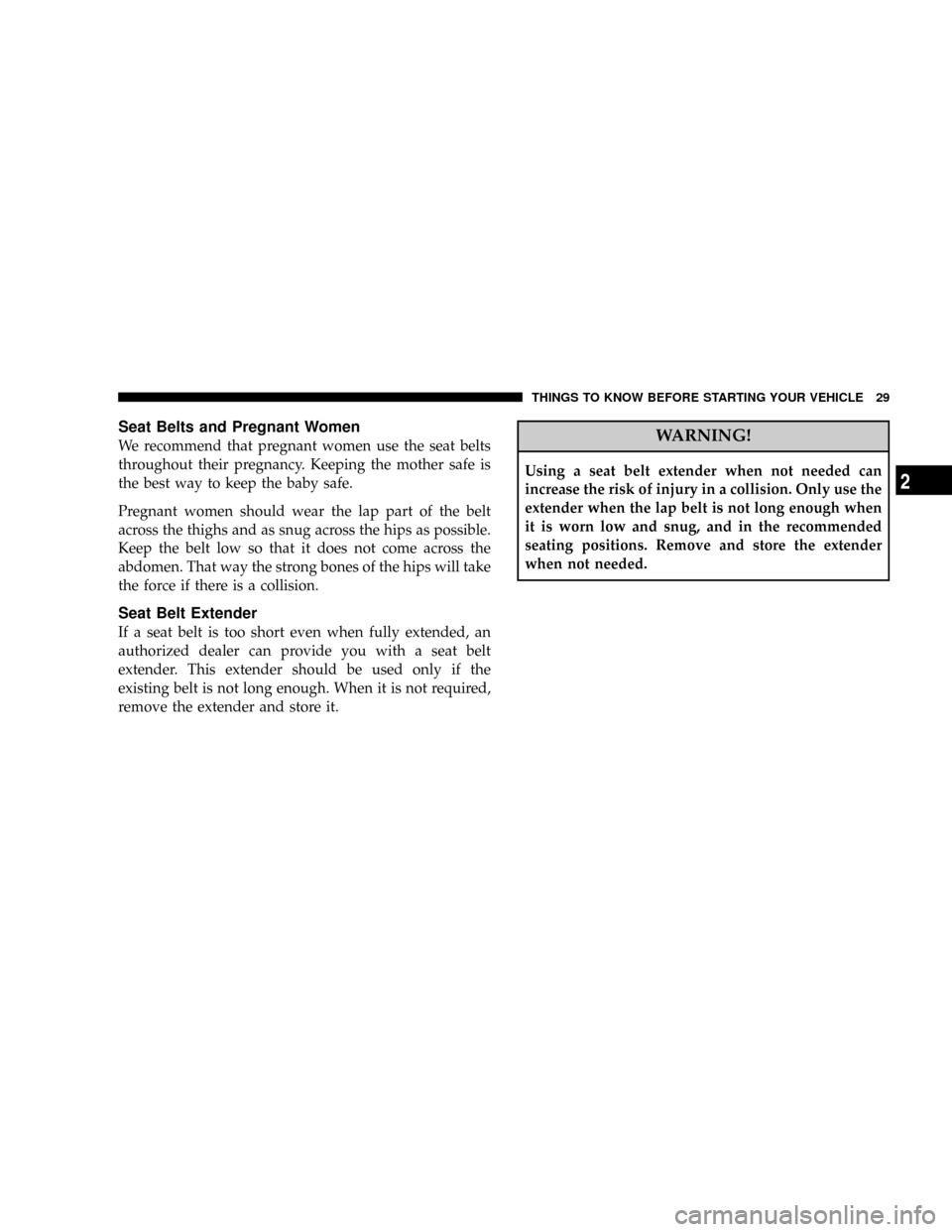
Seat Belts and Pregnant Women
We recommend that pregnant women use the seat belts
throughout their pregnancy. Keeping the mother safe is
the best way to keep the baby safe.
Pregnant women should wear the lap part of the belt
across the thighs and as snug across the hips as possible.
Keep the belt low so that it does not come across the
abdomen. That way the strong bones of the hips will take
the force if there is a collision.
Seat Belt Extender
If a seat belt is too short even when fully extended, an
authorized dealer can provide you with a seat belt
extender. This extender should be used only if the
existing belt is not long enough. When it is not required,
remove the extender and store it.
WARNING!
Using a seat belt extender when not needed can
increase the risk of injury in a collision. Only use the
extender when the lap belt is not long enough when
it is worn low and snug, and in the recommended
seating positions. Remove and store the extender
when not needed.
THINGS TO KNOW BEFORE STARTING YOUR VEHICLE 29
2
Page 30 of 299

Supplemental Restraint System (SRS) - AirbagThis vehicle has airbags for the driver and passenger as a
supplement to the seat belt restraint systems. The driver's
airbag is mounted in the steering wheel. The passenger
frontal airbag is mounted in the instrument panel, under
a cover marked SRS/AIRBAG.
These airbags inflate in higher speed frontal impacts.
They work with the instrument panel inflatable knee
blockers and the seat belts to provide improved protec-
tion for the driver and passenger.
The vehicle is also equipped with side airbags, located in
the driver and passenger doors. Side airbags also work
with seat belts to improve occupant protection.
NOTE:The front driver airbag is certified to the Federal
regulations that allow less forceful deployment. The front
driver airbag has a multi stage inflator design. This may
allow the airbag to have different rates of inflation that
are based on collision severity and occupant size. Also,
the front passenger airbag is certified to the Federal
regulations that define Occupant Classification (Refer to
ªOccupant Classification Systemº in this section). Their
covers are also labeled SRS/AIRBAG.
30 THINGS TO KNOW BEFORE STARTING YOUR VEHICLE
Page 31 of 299
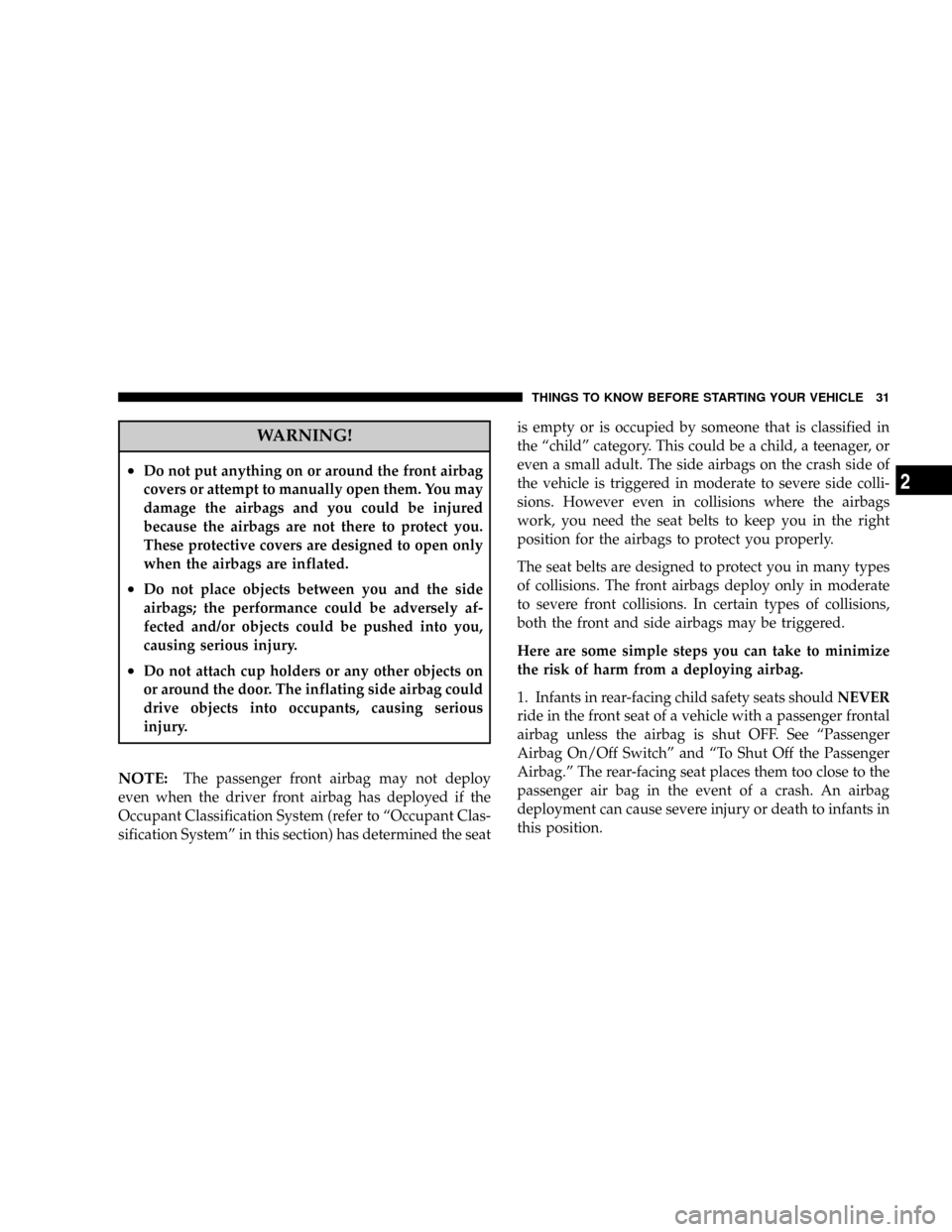
WARNING!
²Do not put anything on or around the front airbag
covers or attempt to manually open them. You may
damage the airbags and you could be injured
because the airbags are not there to protect you.
These protective covers are designed to open only
when the airbags are inflated.
²Do not place objects between you and the side
airbags; the performance could be adversely af-
fected and/or objects could be pushed into you,
causing serious injury.
²Do not attach cup holders or any other objects on
or around the door. The inflating side airbag could
drive objects into occupants, causing serious
injury.
NOTE:The passenger front airbag may not deploy
even when the driver front airbag has deployed if the
Occupant Classification System (refer to ªOccupant Clas-
sification Systemº in this section) has determined the seatis empty or is occupied by someone that is classified in
the ªchildº category. This could be a child, a teenager, or
even a small adult. The side airbags on the crash side of
the vehicle is triggered in moderate to severe side colli-
sions. However even in collisions where the airbags
work, you need the seat belts to keep you in the right
position for the airbags to protect you properly.
The seat belts are designed to protect you in many types
of collisions. The front airbags deploy only in moderate
to severe front collisions. In certain types of collisions,
both the front and side airbags may be triggered.
Here are some simple steps you can take to minimize
the risk of harm from a deploying airbag.
1. Infants in rear-facing child safety seats shouldNEVER
ride in the front seat of a vehicle with a passenger frontal
airbag unless the airbag is shut OFF. See ªPassenger
Airbag On/Off Switchº and ªTo Shut Off the Passenger
Airbag.º The rear-facing seat places them too close to the
passenger air bag in the event of a crash. An airbag
deployment can cause severe injury or death to infants in
this position.
THINGS TO KNOW BEFORE STARTING YOUR VEHICLE 31
2